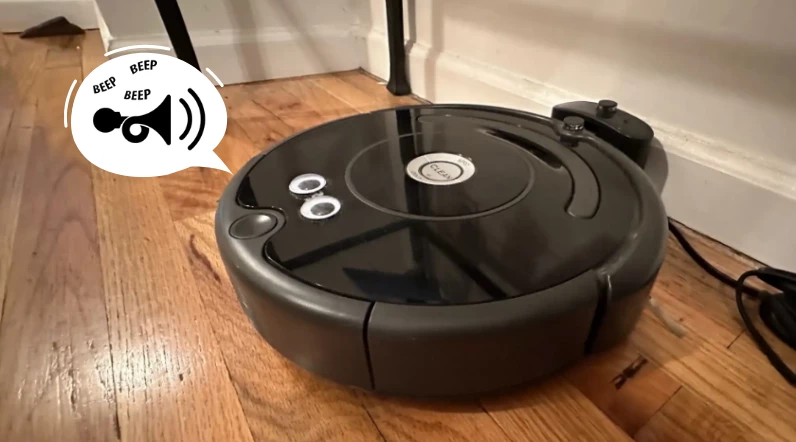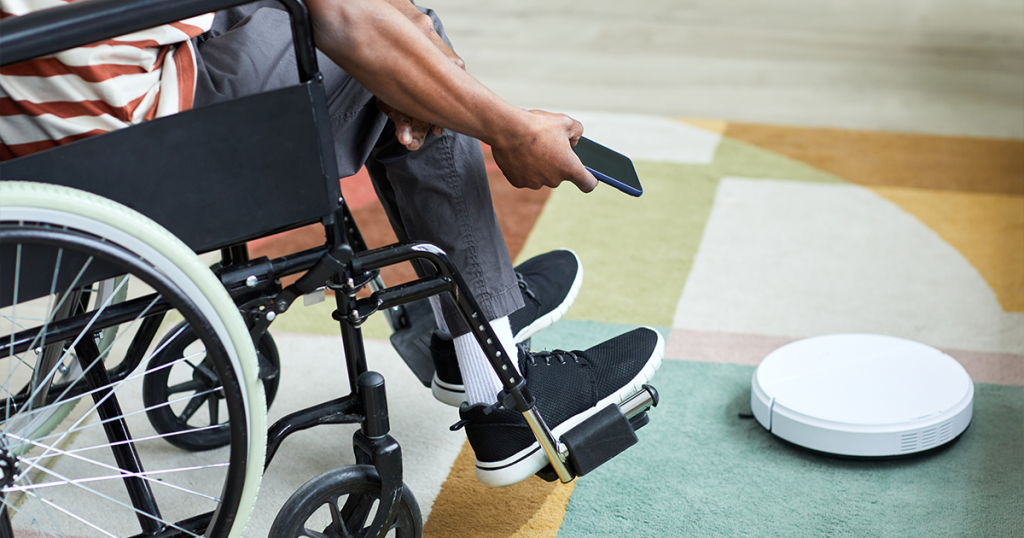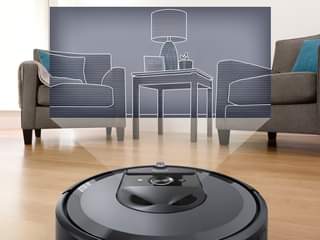Robot vacuums, specifically the Roomba, have significantly improved the lives of people with disabilities by providing them with an accessible way to keep their space clean. The Roomba is an autonomous robot that vacuums floors and relies on sensors to navigate spaces. It runs on a rechargeable battery and can be controlled by an app.
The Roomba was originally intended to simply automate the mundane task of vacuuming, but proved to be an assistive technology that has provided many benefits for the community of people with disabilities. This automated vacuum technology is considered to be accessible because it provides people who are disabled a way to live independently and carry out the task of vacuuming which would have otherwise been very difficult for them. People with limited mobility, impaired vision, and sensory sensitivities are some of the groups of people that are now able to have their house vacuumed. One user who has disabilities that limit her mobility said, ” I used to be able to clean my hard floors once a week, and now they’re clean every day”.
How does it work?
Using the Roomba is intended to be simple, but it should be mentioned that the the first time requires some setup such as downloading the smartphone app, connecting the to the device via bluetooth, and running 3-5 “mapping runs” . The initial setup may require the help of someone, but once it is complete, the Roomba can clean, empty the debris, and recharge itself without any intervention from the user. The Roomba can even be set up to clean on a schedule so that the house can be cleaned on a consistent basis. Many of these features contribute to the utility of this product and allows it’s users to live independently and participate in society despite any disabilities or limitations. Additionally due to it’s automatic capabilities, it can be used by users with a wide range of capabilities which make it accessible according to the E-Accessibility Policy Toolkit for Person’s with Disabilities. In terms of affordability, the price of the Roomba varies between around $200 to $1200 depending on the model. This price range is slightly higher than a traditional vacuum, however it can be argued that the value that the Roomba provides over a traditional vacuum explains the higher cost.
The automatic navigation and audio cue features can be discussed in further detail using the frameworks of disability to truly understand the viability of the Roomba as an assistive technology product.
Automatic Navigation
The Roomba is different from a traditional vacuum cleaner because it can navigate around a space completely by itself and vacuum while doing so. The Roomba has a set of sensors that allow it to avoid obstacles and detect messes on the floor that need to be vacuumed up. According to the social model of disability, this sort of autonomous navigation on a vacuum is needed because regular vacuums are flawed since they require people who are physically capable to maneuver them around a house. The social model would also consider typical living spaces to be flawed since they are difficult to keep clean for people with disabilities. This feature of the Roomba allows those who are disabled to remain functioning members of society and live in clean spaces despite any limitations.
The functional solutions model can also be applied here. The Roomba is the product of true innovation. By using infrared light, the sensors in the robot are able to understand the layout of a room and navigate it autonomously. By using this sort of technology, people with disabilities are able to overcome their own limitations and rely on the robot to carry out the task of vacuuming. According to the medical model, this automatic navigation feature of the Roomba is not a solution for people with disabilities since it does not aim to medically treat the disability.
Audio Cues

Each time the Roomba is powered on, begins vacuuming, or finishes vacuuming, there are a variety of beeps that play from the machine. In addition to the beeps, the robot makes noise while operating and moving around a room. These audio cues are especially helpful for a person who is blind since it provides them with feedback when handling the device and helps them understand where the Roomba is and when it is done. According to the social model of disability, these audio cues are necessary because the onus is on the product to indicate its state and location to the user. This feature also aligns with the functional model since it uses technology to solve the problem of providing feedback to a user who may be blind. Again, this feature is not supported by the medical model since it does not address the biological aspect of blindness.
Conclusion
Considering the Roomba as an assistive technology aligns most closely with the social and functional models of disability. According to the medical model this is not a solution for people with disabilities since it is not addressing the biological cause. The Roomba does not fit the social identity model since this product is not something that is only used by one community of people, nor does it align with the economic model since it does not emphasize the need for economic support for people with disabilities. However because of the utility, accessibility, and affordability of the product, this product is an effective and practical solution for people with disabilities.
References
http://www.e-accessibilitytoolkit.org/toolkit/product_development_and_design/accessible_product
https://blog.irobot.com/physical-disabilities-service-dogs/
https://www.consumer.org.nz/services/robot-vacuum-cleaners/guide

